William Ronald conceived and founded the Painters Eleven in 1953 with fellow artists Jack Bush, Oscar Cahén, Hortnese Gordon, Tom Hodgson, Alexandra Luke, Jock Macdonald, Ray Mead, Kazuo Nakamura and Walter Yarwood. The Roberts Gallery in Toronto was home to the Painters Eleven first exhibition in 1954. It was also the first major commercial abstract art exhibit in Toronto. (painterseleven.com)
It is Museum Month and we are celebrating our collection of Painters Eleven works.
The RMG proudly holds Canada’s largest collection of works by Painters Eleven, primarily as a result of significant donations to the permanent collection from Alexandra Luke. At least eleven of these works are on display at all times in our Painters Eleven gallery.
Learn more about the artists!
Jack Bush:
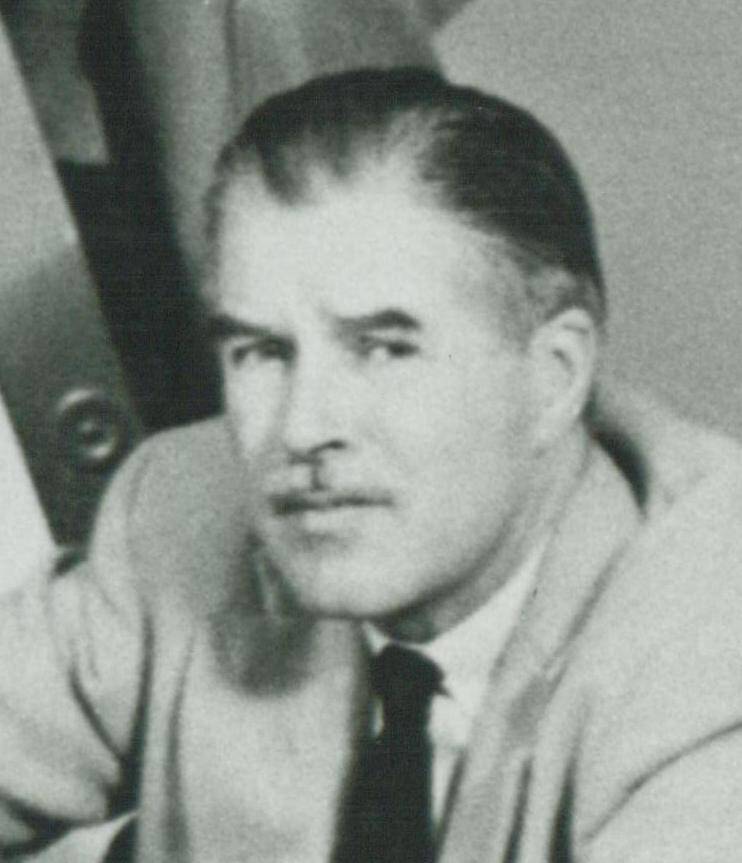
Jack Bush
Jack Bush was born in Toronto, but studied art at the Royal Canadian Academy in Montreal. Bush drew his inspiration from Charles Comfort, a Group of Seven protégé and one of his instructors at the Ontario College of Arts. Bush painted landscapes in the Group style.
After his first trip to visit the Museum of Modern Art in New York in 1950, Bush redirected his vision and efforts to large-scale expressionist paintings. Bush found Clement Greenberg, a New York art critic, to become his mentor and encourage him to narrow his sight. Bush later simplified his compositions and abandoned his abstract expressionist style. He represented Canada in 1967 at the Sao Paulo Art Biennial, and later retired as a commercial artist in 1968.
Oscar Cahén:

Oscar Cahen
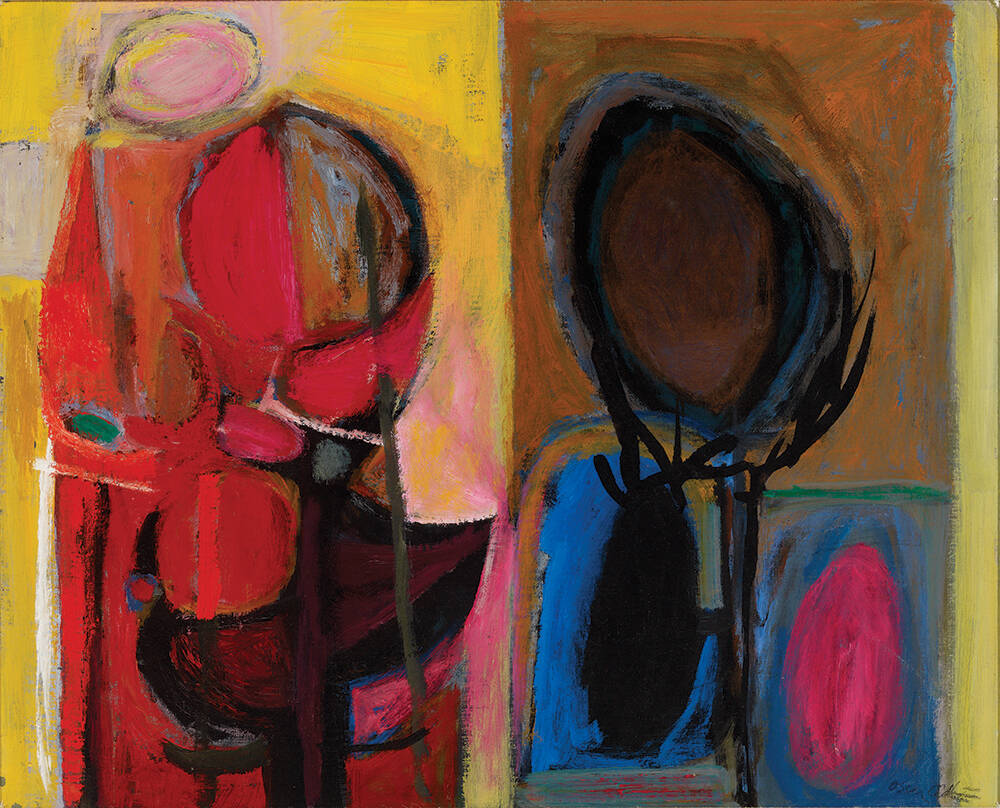
Oscar Cahén (Canadian, b. Denmark, 1916 – 1956)
Small Structure, 1953/55
Oil on canvas board
Gift of Alexandra Luke, 1967
Oscar Cahén was born Copenhagen, Denmark and studied drawing, painting, design and illustration in Germany, Italy, France, Sweden, and Czechoslovakia. Cahén became a professor of design, illustration and painting at the Rotter School in Prague after receiving a Master’s Degree in Fine Arts from Kunstakadekamie in Dresden.
In 1940, Cahén came to Canada as a war internee, the son of a German diplomat turned anti-Nazi. When he was released he moved to Toronto and met Walter Yarwood and Harold Town. Cahén aligned himself with the avante-garde art in the city and became one of Canada’s leading magazine illustrators. He started as a dark expressionist painter, but later changed his style to bright coloured abstractions.
Hortense Gordon:
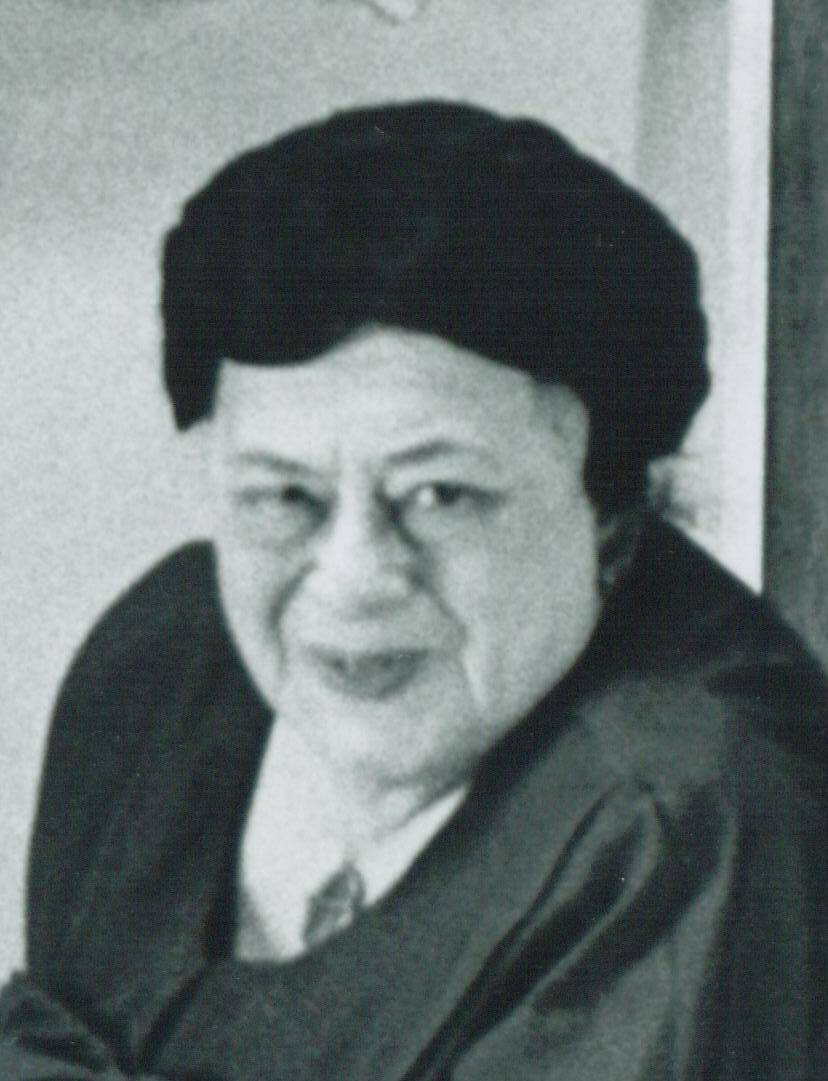
Hortense Gordon
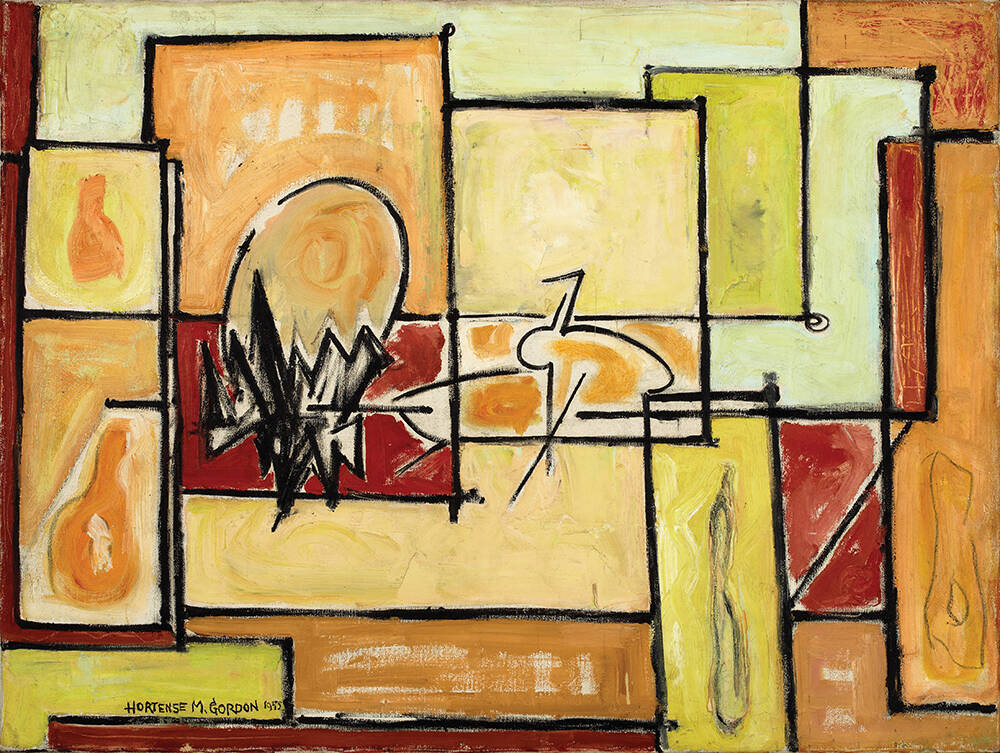
Hortense Gordon
(Canadian, 1887 -1961)
Horizontals and Verticals, 1955
Oil on canvas
Gift of Charlie Dobbie, 2000
Hortense (Mattice) Gordon was born in Hamilton and studied under John Sloan Gordon at the Hamilton Art School. She later married John Gordon in 1920. Gordon taught at the Hamilton Technical School from 1916 – 1951.
Gordon was the first Canadian to study with Hans Hofmann, along with fellow members Alexandra Luke and William Ronald. She was a proponent of Hofmann’s “push and pull” theory, which shows in her geometric abstractions. Gordon began experimenting with abstractions in the 1930’s and was drawn to Piet Mondrian’s style of pure design and colour. She was inducted into the Painters Eleven by Ray Mead.
Tom Hodgson:
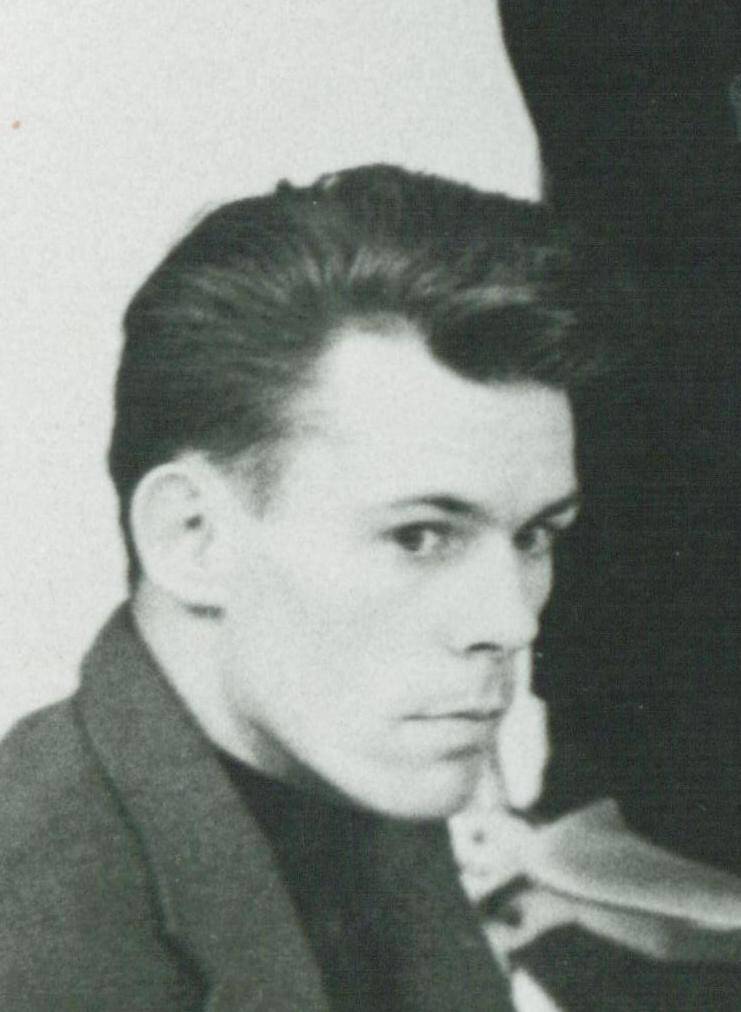
Tom Hodgson
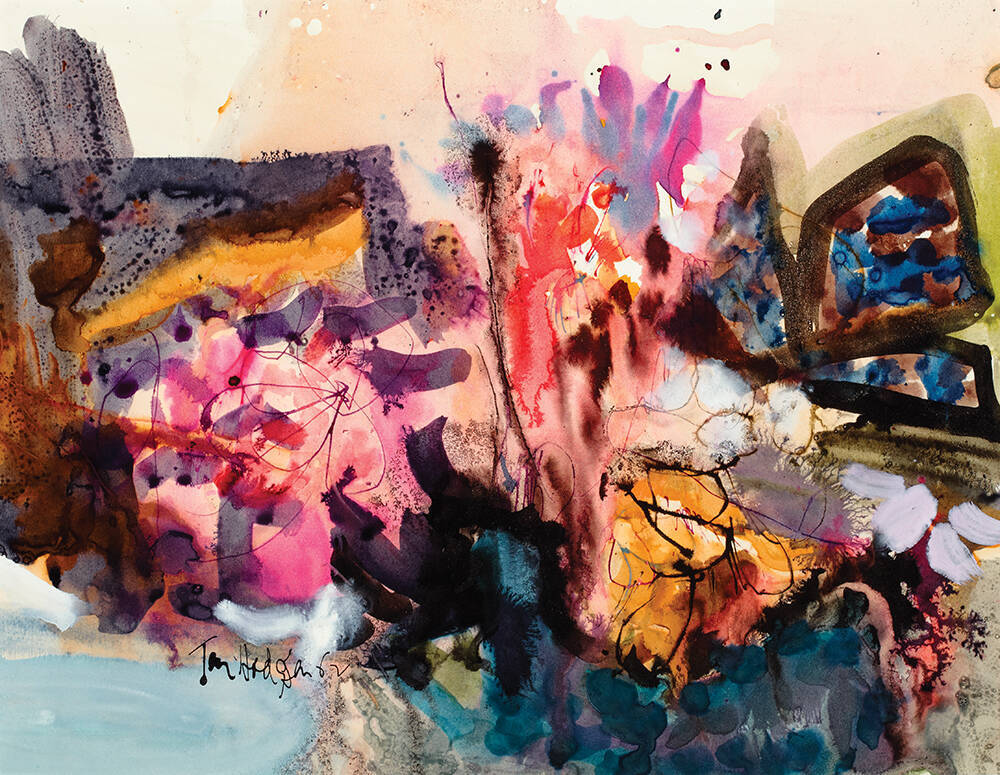
Tom Hodgson
(Canadian, 1924 – 2006)
Flowers, 1962
Watercolour and ink on illustration board
Gift of Alexandra Luke, 1967
Tom Hodgson was a Canadian representative at the 1952 Helsinki and 1956 Melbourne Olympics as a sprint canoer. Hodgson grew up on Toronto’s Centre Island, where he learned to paddle as a child, leading to his Olympic participation.
As well as being an international athlete, Hodgson was also a gifted artist from an early age. He studied with Arthur Lismer at the Art Gallery of Toronto (now known as the Art Gallery of Ontario), the Central Technical School and like other members of the Painters Eleven he also studied at the Ontario College of Art. Hodgson’s work was chosen for exhibition at the 1955 Pittsburgh International Exhibition. At the exhibition, Hodgson was amazed by the large size of the canvases used by other abstract painters, which paved the way for his own large-scale spontaneous gestural works.
Alexandra Luke:
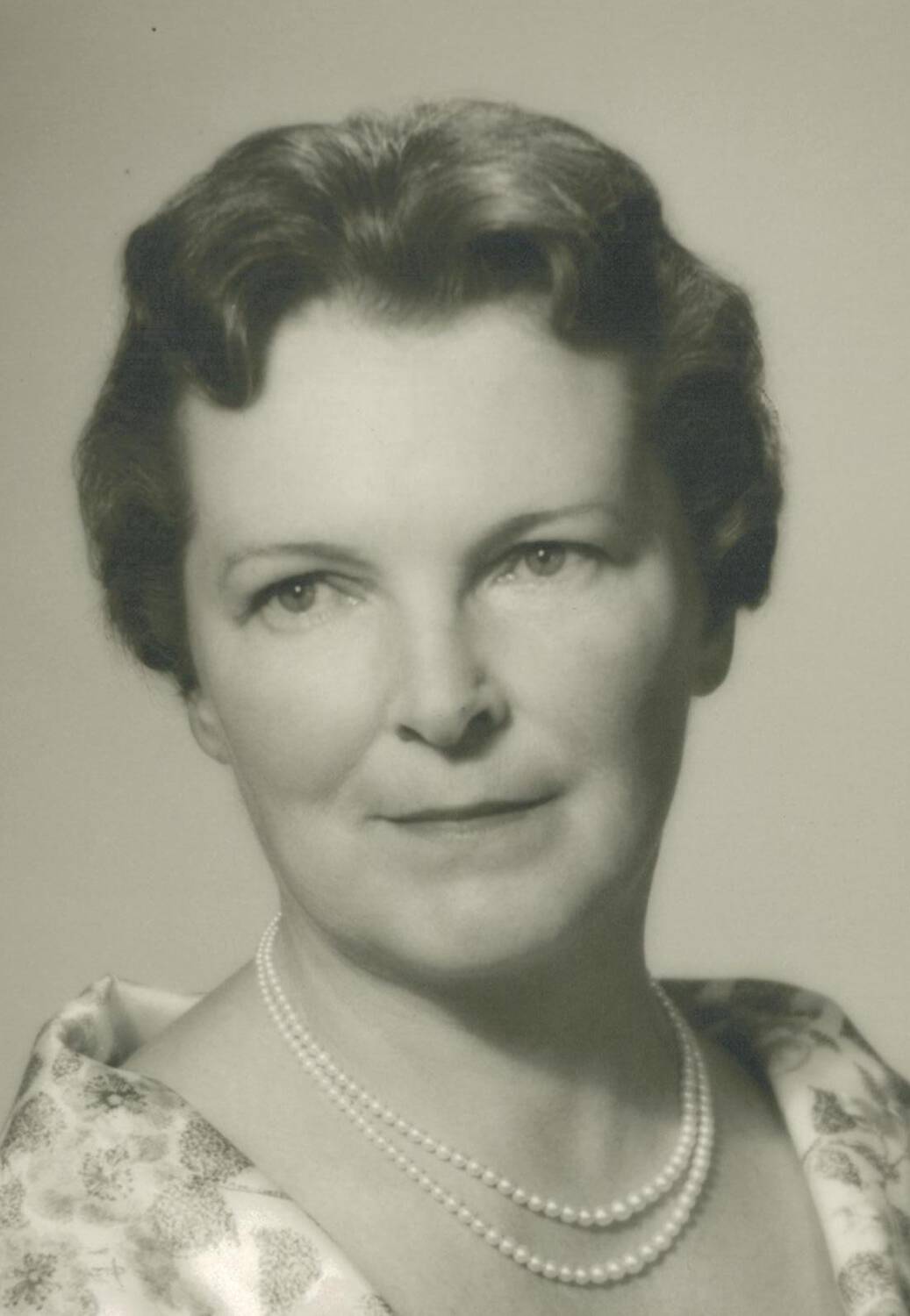
Alexandra Luke
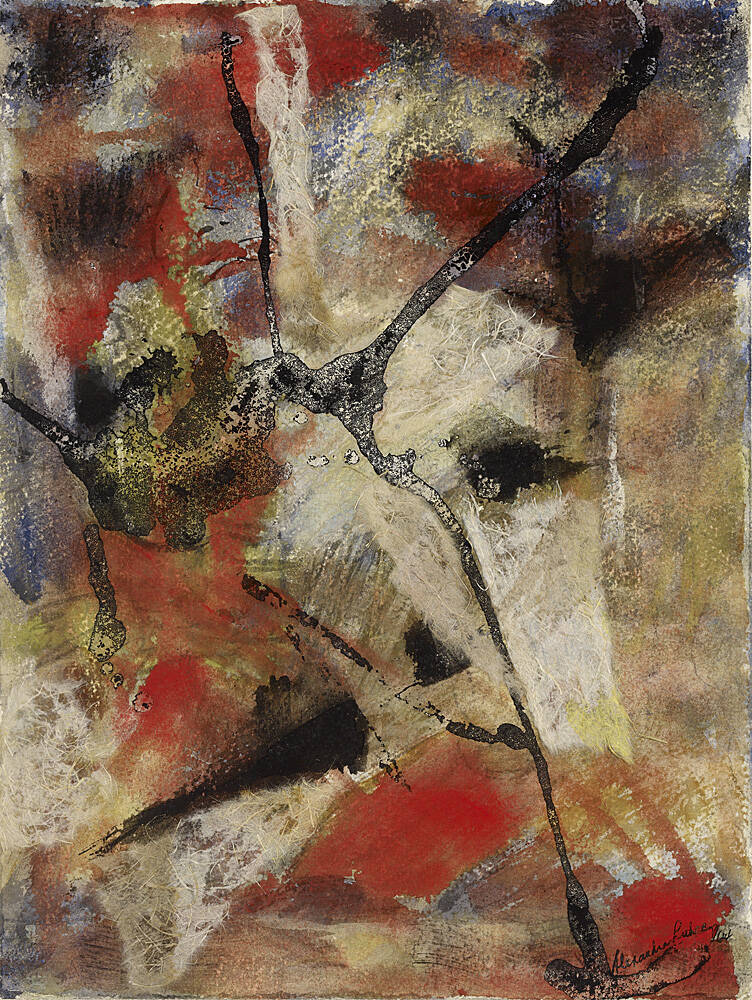
Alexandra Luke
Blythwood
1965
Watercolour and ink on paper
Alexandra Luke was born in Montreal, but moved to Oshawa in 1914. She was enrolled in the Banff School of Fine Arts, where she met Jock Macdonald in 1945. Jock Macdonald took Luke under his wing, she also studied with American abstract artist Hans Hofmann.
Macdonald introduced Luke to Surrealism and Theosophy: a spiritual dimension that was significant to Luke’s work. Luke was instrumental in the creating the Painters Eleven by organizing the Canadian Abstract Exhibition in 1952, the first all-abstract Canada wide exhibit. Members of the future group were present at the exhibition.
Jock Macdonald:
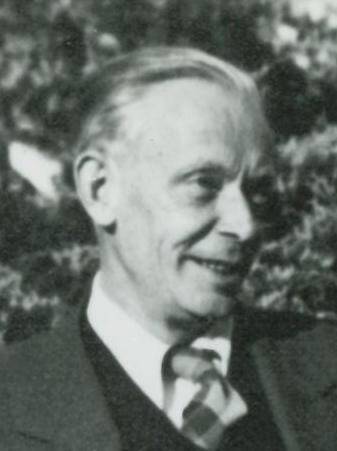
Jock Macdonald
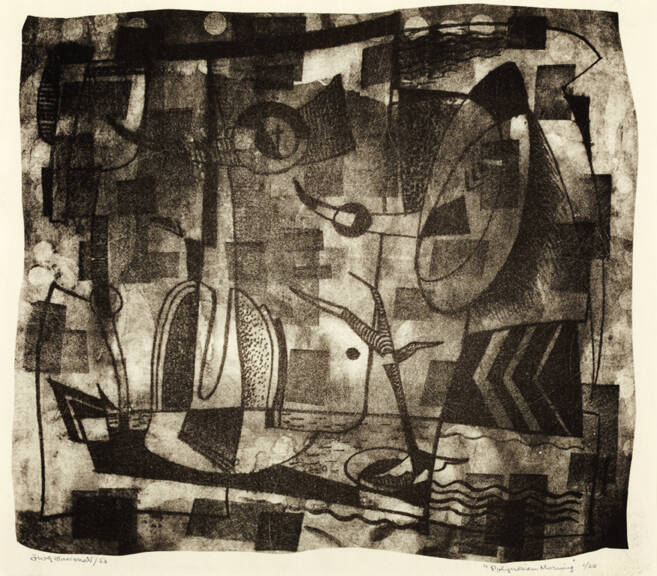
Jock Macdonald
(1897 – 1960)
Polynesian Morning
1953
Lithograph on paper
Purchased, 2009
Jock Macdonald was born in Thurso, Scotland and graduated from the Edinburgh College of Art in 1922. Macdonald later moved to Vancouver to teach at the Vancouver School of Decorative and Applied Arts.
With traditional influences by the Group of Seven, after his move to Vancouver, Macdonald he developed a surrealist style through Grace Pailthorpe. His meeting with Pailthorpe inspired him to start making large-scaled abstractions. Macdonald started teaching at the Ontario College of Art in 1947. His position as a professor at the college gave him an influential part on fellow Painters Eleven members William Ronald and Alexandra Luke.
Ray Mead:

Ray Mead
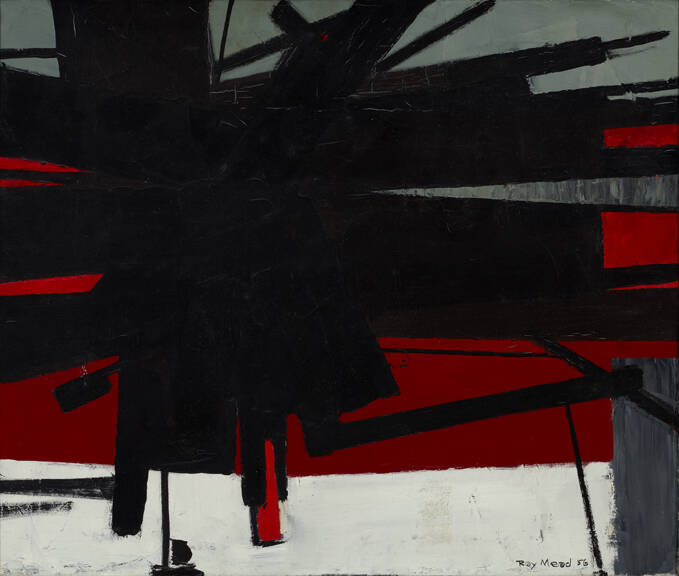
Ray Mead
1956
Tide #22
Oil painting on canvas
Gift of Avrom Isaacs, 1987
Ray Mead was born in England, but was stationed in Hamilton as a part of the Royal Air Force. Eventually he immigrated to Hamilton, where he met Hortense Gordon. Mead’s connection to Gordon was strong and very influential to his work. Mead said, “she educated me more than any art school.”
Mead worked for the MacLaren Advertising Company in Toronto, now known as MacLaren McCann and Montreal as a commercial artist, but he returned to Toronto in 1987 to paint full time. Nicolas de Staël, a European abstract artist, heavily influenced Mead’s work. His personal style is often characterized by the use of rich fields of colour.
Kazuo Nakamura:
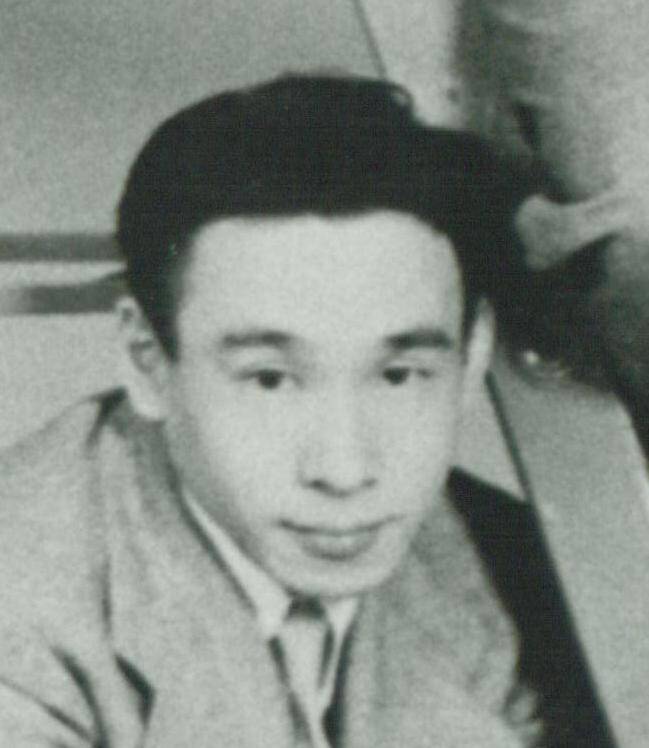
Nakamura
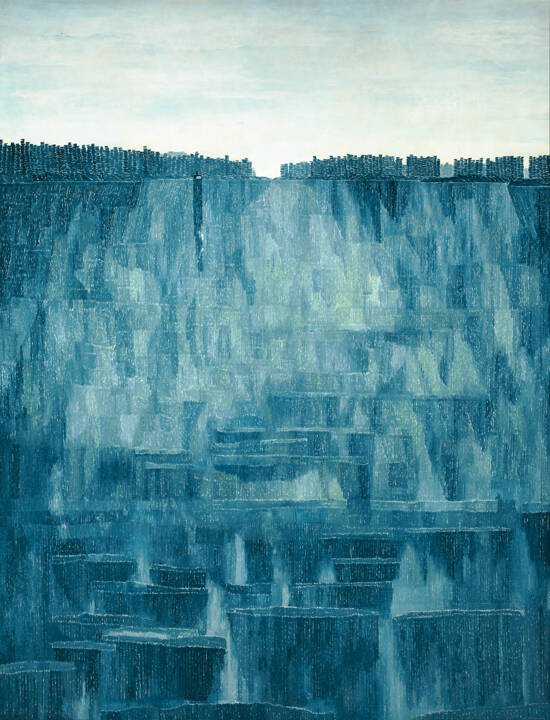
Kazuo Nakamura
1964
Lake B. C.
Oil painting on canvas
Gift of Ron and Mary Tasker, 1991
Kazuo Nakamura was born in Vancouver, but was interned with his Japanese family in Hope, British Columbia during WWII. After the war, he moved to Hamilton and met Hortense Gordon for classes before enrolling at the Central Technical School in Toronto.
Nakamura uses a simpler style in his work, with less complex structures and monochromatic colours, as compared to the expressionistic work of other Painters Eleven members. Nakamura’s work is evident of his fascination with science and mathematics. His use of patterns, linear perspectives and processes. Nakamura has said, “In a sense, scientists and artists are doing the same thing. This world of pattern is a world we are discovering together.”
William Ronald:
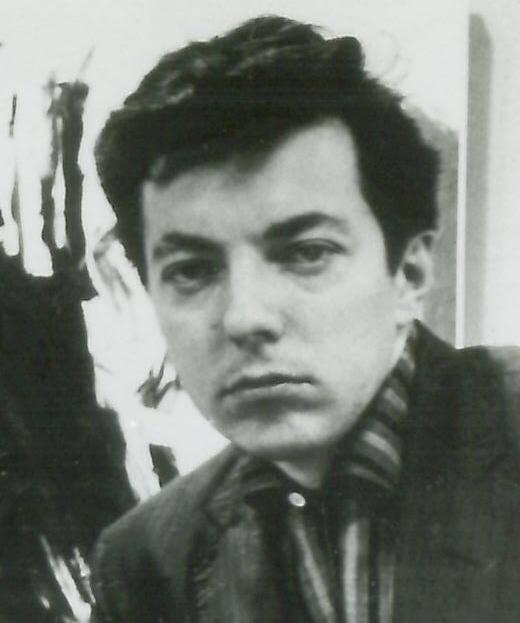
William Ronald
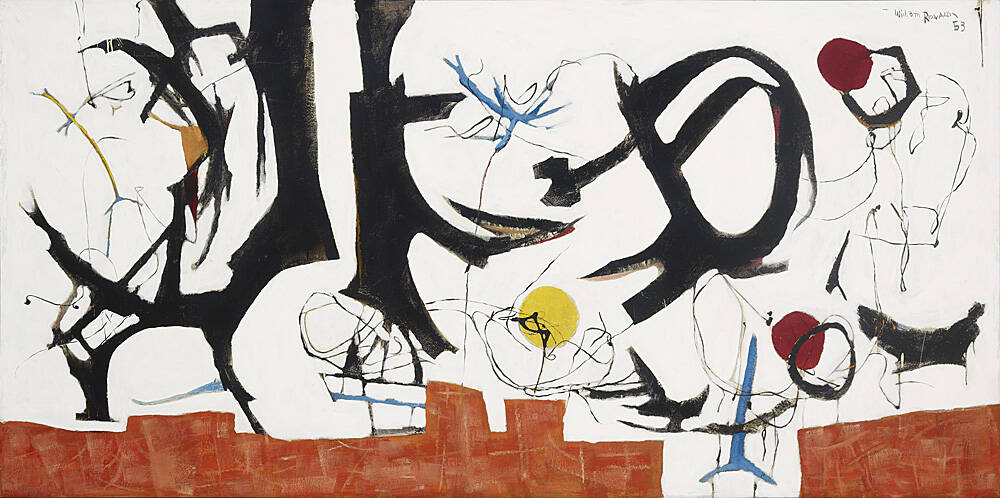
William Ronald
1953
Slow Movement
Casein duco graphite on masonite
Purchase, 1971
William Ronald Smith was born in Stratford, graduated from the Ontario College of Art and studied with Hans Hofmann in New York in 1952. Ronald was inspired by the abstract expressionist movement happening in New York City, and brought it back to Toronto while working at Simpson’s Company as a display artist. Ronald organized the Abstracts at Home display at Simpson’s, which initiated the Painters Eleven.
Ronald moved to New York in 1955 and secured a spot in the Kootz Gallery. His spot in the gallery got him known for his central image paintings, which are expressionist painting that have immediate impact on the viewer. Ronald is known as one of Canada’s most significant international artists of the 1950’s.
Harold Town:
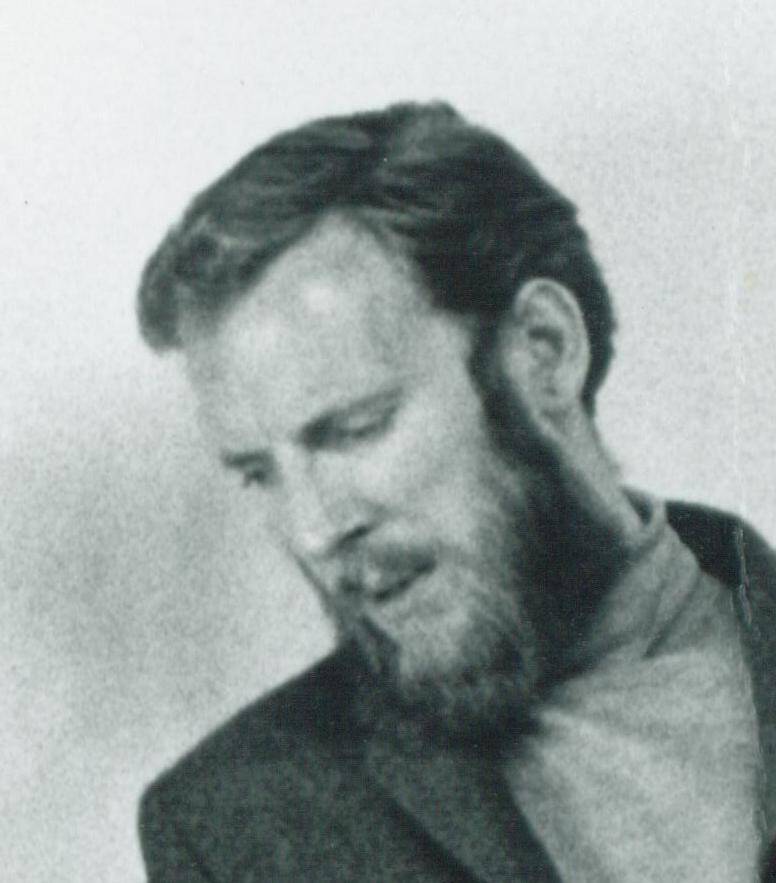
Harold Town
Harold Town was born in Toronto and studied at Western Technical School and the Ontario College of Art. Town’s early work contained distinctly spiky forms, showing influence from Graham Sutherland and Rico Lebrun. He worked in a variety of mediums and showed off his flamboyant and productive personality in his artwork. Town worked with collages, printmaking, drawing, painting and sculpture. “Absorb experience common to all and subsume it in uncommon expression,” wrote Town about his use of everyday items in his work.
Town was a Canadian representative in two Venice Biennales along with being gifted an Honorary Doctorate from York University.
Walter Yarwood:
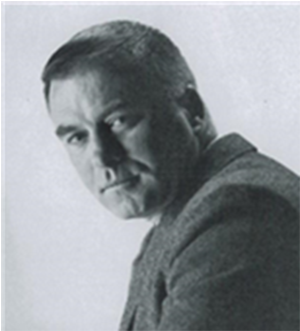
Walter Yarwood
Walter Yarwood was born in Toronto and studied commercial art at Western Technical School. Yarwood considered himself largely self-taught. He worked as a freelance artist for advertising companies where he met Oscar Cahén and Harold Town.
Yarwood’s work is known for its rich and commanding sense of colour. He gave up painting to take up sculpturing, receiving commissions including work at the University of Toronto, Winnipeg International Airport and York University. After becoming an instructor at Humber College in the 1970’s, he resumed painting in 1980.
Visit the RMG to see works by the Painters Eleven, or browse our collection online..